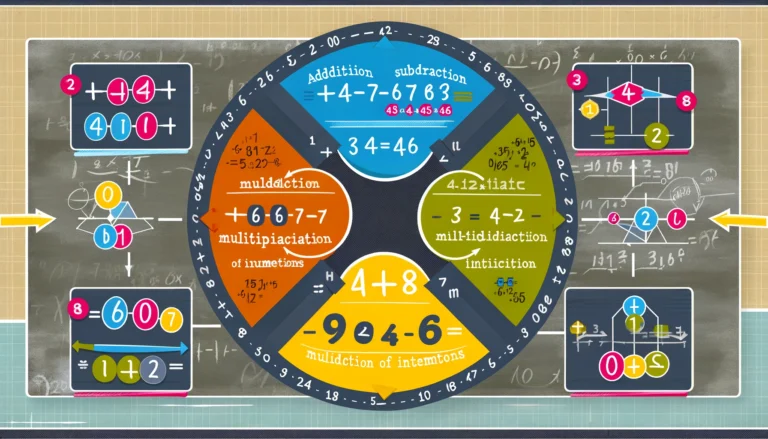1. Adding Integers
Adding integers is similar to adding whole numbers, but you must consider the sign (positive or negative) of each number.
Rules for Adding Integers:
- Same Signs: Add their absolute values (ignore the sign), and keep the common sign.
- Different Signs: Subtract the smaller absolute value from the larger absolute value, and take the sign of the number with the larger absolute value.
(Both numbers are positive.)
(Both numbers are negative, add their absolute values and keep the negative sign.)
(Numbers have different signs, subtract the smaller absolute value from the larger one, and keep the sign of the number with the larger absolute value.)
2. Subtracting Integers
To subtract integers, add the opposite of the number being subtracted.
Rule for Subtracting Integers:
- Convert the subtraction operation into an addition operation by adding the additive inverse (opposite) of the number to be subtracted.
3. Multiplying Integers
Multiplying integers involves considering the signs of the numbers as well as their values.
Rules for Multiplying Integers:
- Same Signs: The product is positive.
- Different Signs: The product is negative.
4. Dividing Integers
Dividing integers follows the same sign rules as multiplying integers.
Rules for Dividing Integers:
- Same Signs: The quotient is positive.
- Different Signs: The quotient is negative.
Practice Problems
Try these problems to test your understanding:
Practice Problems with Solution
Try these problems to test your understanding:
Operations with Integers FAQs
What are integers?
Integers are whole numbers, which means they are not fractions or decimals. Integers include positive whole numbers (1, 2, 3, ...), negative whole numbers (-1, -2, -3, ...), and zero (0).
How do you add integers?
- **Same Signs:** Add the absolute values and keep the common sign.
Example: 5 + 3 = 8; -5 + (-3) = -8 - **Different Signs:** Subtract the smaller absolute value from the larger absolute value. The answer takes the sign of the integer with the larger absolute value.
Example: 5 + (-3) = 2; -5 + 3 = -2
How do you subtract integers?
To subtract integers, you can "add the opposite". Change the subtraction sign to an addition sign and change the sign of the second integer to its opposite. Then follow the rules for addition.
Example: 5 - 3 = 5 + (-3) = 2
Example: 3 - 5 = 3 + (-5) = -2
Example: -5 - 3 = -5 + (-3) = -8
Example: -5 - (-3) = -5 + 3 = -2
How do you multiply integers?
- **Same Signs:** The product is positive.
Example: 5 × 3 = 15; -5 × (-3) = 15 - **Different Signs:** The product is negative.
Example: 5 × (-3) = -15; -5 × 3 = -15
How do you divide integers?
The rules for division signs are the same as for multiplication signs (assuming the divisor is not zero):
- **Same Signs:** The quotient is positive.
Example: 15 ÷ 3 = 5; -15 ÷ (-3) = 5 - **Different Signs:** The quotient is negative.
Example: 15 ÷ (-3) = -5; -15 ÷ 3 = -5
Division by zero is undefined.
What happens when you perform these operations with integers?
The set of integers is "closed" under addition, subtraction, and multiplication. This means that when you add, subtract, or multiply any two integers, the result will always be another integer.
However, the set of integers is **not** closed under division. Dividing one integer by another may result in a fraction or decimal that is not an integer (e.g., 5 ÷ 2 = 2.5). The result of integer division is only guaranteed to be an integer if the dividend is a multiple of the divisor.

